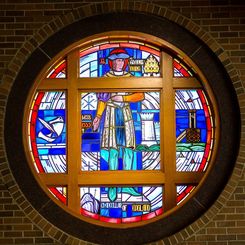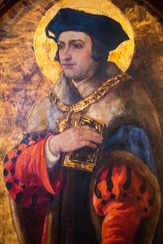Thomas More - Chancellor and Saint
Feast Day - June 22nd
The king's good servant, but God's first.
The king's good servant, but God's first.
Our parish was not always known by the name of St. Thomas More. The parish was started by two men named Thomas: Bishop Thomas O'Gorman and Father William Thomas Shean. Thus, it seemed appropriate that they named the church St. Thomas, although it isn't known which of the many saints named Thomas was intended. It wasn't until 1954, after the second church was built that the community settled on the name St Thomas More, in honor of the lay saint of England.
Scholar, statesman and martyr, Sir Thomas More remained humble and modest throughout his life. He was lionized for the modern world in drama and film with the production of "A Man for All Seasons." This saint is unique because he was canonized for being true to Christian discipleship as a layman, a married man and a public statesman.
More was born in 1477, one of five children. His father, John More was knighted and became a judge during the reign of HenryVII. At that time, it was the custom for sons to become apprentices to influential persons of trade, service or ministry. Thus, at age 12, Thomas was placed as a page in the house of John Morton, the Cardinal-Archbishop of Canterbury and Lord Chancellor of England. In 1492, he entered Oxford where he admired the humanists greatly. More later wrote the significant works Richard III and Utopia, a book that revealed his Christian humanism. After attending Oxford, he studied law.
Throughout these years, his spirituality became even deeper. More considered a religious vocation and even spent four years with Carthusian monks in London. He never took vows with them, however, and later married Jane Colt with whom he had for children: Margaret, Elizabeth, Cecily and John. Within eight years of marriage, his wife died, and More later married Alice Middleton.
More was so respected among literary and learned circles that the famous Erasmus lamented that "England's only genius" had to spend so much time on royal and legal work that he could not spend much time writing. Yet More's reputation for being a just and fair legal mind brought him a host of clients.Because of this, More is the patron saint of lawyers, judges and university students. Often Bishops will offer the annual "RED" Mass for those associated with the legal profession.
When King HenryVIII was crowned, he knew of More's reputation and employed him on international missions to Europe. More struggled with his decision to enter the king's service because he sensed that it was a compromise between what is ideal in any nation state and what could be practically accomplished.
In 1521, he became Under-Treasurer of the Exchequer and was knighted. In 1523,he became a speaker of Parliament, and in 1924, he was appointed high steward of Oxford University. Later he accepted the same position for Cambridge.During this time, as the protestant reformation was sweeping Europe, More wrote and spoke convincingly to defend the Catholic tradition and its answers in matters of faith. In 1529, More became Lord Chancellor of all England.
A rift between More and Henry VIII began to develop because More would not agree to Henry's divorce and would not call the king the spiritual and political head of the church in England. More resigned in 1532 rather than give his oath of submission to the king in his separation from the Catholic Church. Henry and his associates tried to entrap More in many legal ruse but were outwitted time and again by More's legal brilliance and honesty. More said his conscience was supreme as his guide and argued for freedom of conscience. That kind of independent thinking was too much for HenryVIII and in 1535, More was beheaded for high treason and his head was displayed on London Bridge. His daughter Margaret later recovered and buried his head in Roper's vault in Canterbury. His body is buried in the chapel of St. Pete in the tower. More's death was lamented throughout Europe, but he was not canonized until 1935. His feast day is June 22 along with other English martyrs for the faith.
Written by Rev. Michael Wensing (former Pastor of Saint Thomas More Parish)
From - 100 Years of Faith - History of Saint Thomas More Parish (1904-2004)
Our parish was not always known by the name of St. Thomas More. The parish was started by two men named Thomas: Bishop Thomas O'Gorman and Father William Thomas Shean. Thus, it seemed appropriate that they named the church St. Thomas, although it isn't known which of the many saints named Thomas was intended. It wasn't until 1954, after the second church was built that the community settled on the name St Thomas More, in honor of the lay saint of England.
Scholar, statesman and martyr, Sir Thomas More remained humble and modest throughout his life. He was lionized for the modern world in drama and film with the production of "A Man for All Seasons." This saint is unique because he was canonized for being true to Christian discipleship as a layman, a married man and a public statesman.
More was born in 1477, one of five children. His father, John More was knighted and became a judge during the reign of HenryVII. At that time, it was the custom for sons to become apprentices to influential persons of trade, service or ministry. Thus, at age 12, Thomas was placed as a page in the house of John Morton, the Cardinal-Archbishop of Canterbury and Lord Chancellor of England. In 1492, he entered Oxford where he admired the humanists greatly. More later wrote the significant works Richard III and Utopia, a book that revealed his Christian humanism. After attending Oxford, he studied law.
Throughout these years, his spirituality became even deeper. More considered a religious vocation and even spent four years with Carthusian monks in London. He never took vows with them, however, and later married Jane Colt with whom he had for children: Margaret, Elizabeth, Cecily and John. Within eight years of marriage, his wife died, and More later married Alice Middleton.
More was so respected among literary and learned circles that the famous Erasmus lamented that "England's only genius" had to spend so much time on royal and legal work that he could not spend much time writing. Yet More's reputation for being a just and fair legal mind brought him a host of clients.Because of this, More is the patron saint of lawyers, judges and university students. Often Bishops will offer the annual "RED" Mass for those associated with the legal profession.
When King HenryVIII was crowned, he knew of More's reputation and employed him on international missions to Europe. More struggled with his decision to enter the king's service because he sensed that it was a compromise between what is ideal in any nation state and what could be practically accomplished.
In 1521, he became Under-Treasurer of the Exchequer and was knighted. In 1523,he became a speaker of Parliament, and in 1924, he was appointed high steward of Oxford University. Later he accepted the same position for Cambridge.During this time, as the protestant reformation was sweeping Europe, More wrote and spoke convincingly to defend the Catholic tradition and its answers in matters of faith. In 1529, More became Lord Chancellor of all England.
A rift between More and Henry VIII began to develop because More would not agree to Henry's divorce and would not call the king the spiritual and political head of the church in England. More resigned in 1532 rather than give his oath of submission to the king in his separation from the Catholic Church. Henry and his associates tried to entrap More in many legal ruse but were outwitted time and again by More's legal brilliance and honesty. More said his conscience was supreme as his guide and argued for freedom of conscience. That kind of independent thinking was too much for HenryVIII and in 1535, More was beheaded for high treason and his head was displayed on London Bridge. His daughter Margaret later recovered and buried his head in Roper's vault in Canterbury. His body is buried in the chapel of St. Pete in the tower. More's death was lamented throughout Europe, but he was not canonized until 1935. His feast day is June 22 along with other English martyrs for the faith.
Written by Rev. Michael Wensing (former Pastor of Saint Thomas More Parish)
From - 100 Years of Faith - History of Saint Thomas More Parish (1904-2004)


